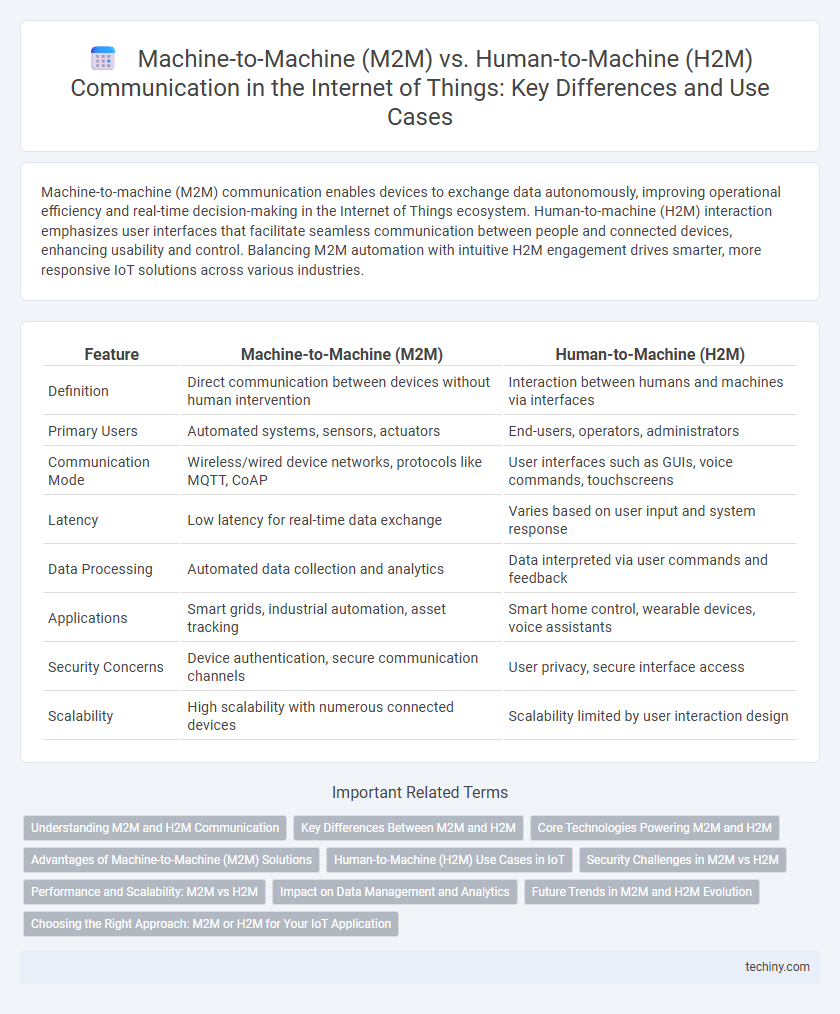Machine-to-machine (M2M) communication enables devices to exchange data autonomously, improving operational efficiency and real-time decision-making in the Internet of Things ecosystem. Human-to-machine (H2M) interaction emphasizes user interfaces that facilitate seamless communication between people and connected devices, enhancing usability and control. Balancing M2M automation with intuitive H2M engagement drives smarter, more responsive IoT solutions across various industries.
Table of Comparison
| Feature | Machine-to-Machine (M2M) | Human-to-Machine (H2M) |
|---|---|---|
| Definition | Direct communication between devices without human intervention | Interaction between humans and machines via interfaces |
| Primary Users | Automated systems, sensors, actuators | End-users, operators, administrators |
| Communication Mode | Wireless/wired device networks, protocols like MQTT, CoAP | User interfaces such as GUIs, voice commands, touchscreens |
| Latency | Low latency for real-time data exchange | Varies based on user input and system response |
| Data Processing | Automated data collection and analytics | Data interpreted via user commands and feedback |
| Applications | Smart grids, industrial automation, asset tracking | Smart home control, wearable devices, voice assistants |
| Security Concerns | Device authentication, secure communication channels | User privacy, secure interface access |
| Scalability | High scalability with numerous connected devices | Scalability limited by user interaction design |
Understanding M2M and H2M Communication
Machine-to-machine (M2M) communication enables devices to exchange data autonomously through embedded sensors and software, driving automated processes in IoT networks. Human-to-machine (H2M) interaction involves direct user engagement via interfaces such as voice commands, touchscreens, or augmented reality, facilitating real-time control and feedback. Understanding the distinct protocols and data exchange mechanisms in M2M and H2M is crucial for optimizing IoT system efficiency and user experience.
Key Differences Between M2M and H2M
Machine-to-machine (M2M) communication involves direct data exchange between devices without human intervention, enabling automated processes and real-time analytics in Internet of Things (IoT) ecosystems. Human-to-machine (H2M) interaction requires user input and commands to control devices, emphasizing usability and interface design for effective control and feedback. Key differences include the autonomy level, with M2M emphasizing device independence, whereas H2M prioritizes seamless user engagement and interface responsiveness.
Core Technologies Powering M2M and H2M
Core technologies powering Machine-to-Machine (M2M) communication include embedded sensors, wireless connectivity protocols such as LTE and NB-IoT, and edge computing for real-time data processing. Human-to-Machine (H2M) interaction leverages advanced natural language processing, voice recognition systems, and gesture-based interfaces to facilitate intuitive user experiences. Both paradigms rely on cloud platforms and artificial intelligence to enhance data analytics, automation, and system responsiveness within Internet of Things ecosystems.
Advantages of Machine-to-Machine (M2M) Solutions
Machine-to-Machine (M2M) solutions enable autonomous data exchange between devices, resulting in faster real-time communication and reduced human error. These systems improve operational efficiency by optimizing processes through continuous monitoring and predictive maintenance without human intervention. M2M technology scales seamlessly for applications in smart cities, industrial automation, and logistics, delivering higher reliability and lower operational costs compared to human-to-machine (H2M) interactions.
Human-to-Machine (H2M) Use Cases in IoT
Human-to-Machine (H2M) use cases in IoT emphasize direct interaction between users and connected devices, enabling real-time control and data monitoring in smart homes, healthcare, and industrial automation. Wearable health devices collect biometric data and provide instant feedback, enhancing personalized care and patient engagement. Smart building systems allow occupants to adjust environmental settings through voice commands or mobile apps, optimizing comfort and energy efficiency.
Security Challenges in M2M vs H2M
Machine-to-machine (M2M) communication faces heightened security challenges due to the lack of direct human oversight, increasing vulnerability to automated attacks, device impersonation, and data interception. Human-to-machine (H2M) interactions incorporate user authentication and discretionary control layers, which can mitigate unauthorized access but remain susceptible to social engineering and insider threats. Securing M2M requires robust encryption, mutual device authentication, and anomaly detection to prevent large-scale systemic breaches in Internet of Things (IoT) ecosystems.
Performance and Scalability: M2M vs H2M
Machine-to-machine (M2M) communication demonstrates superior performance and scalability compared to human-to-machine (H2M) interactions due to automated data exchange and minimal latency in IoT ecosystems. M2M systems efficiently handle massive volumes of connected devices, enabling real-time analytics and decision-making without human intervention. In contrast, H2M interactions are limited by user response times and interface constraints, reducing scalability and throughput in large-scale IoT deployments.
Impact on Data Management and Analytics
Machine-to-machine (M2M) communication generates continuous streams of structured data, enabling real-time analytics and automated decision-making essential for scalable Internet of Things (IoT) systems. Human-to-machine (H2M) interactions introduce unstructured data types, such as voice commands and gesture inputs, requiring advanced natural language processing and sentiment analysis tools for effective interpretation. The integration of M2M and H2M data sources enhances predictive analytics accuracy, but demands sophisticated data management strategies to handle diverse data formats and ensure data integrity across IoT platforms.
Future Trends in M2M and H2M Evolution
Future trends in machine-to-machine (M2M) communication emphasize autonomous data exchange, driven by advancements in edge computing and 5G connectivity, enabling real-time decision-making without human intervention. Human-to-machine (H2M) evolution focuses on enhanced interaction using natural language processing, augmented reality, and AI-powered voice assistants, creating more intuitive and seamless user experiences. The convergence of M2M and H2M technologies will foster smarter IoT ecosystems, integrating automated processes with human insight for optimized performance and adaptability.
Choosing the Right Approach: M2M or H2M for Your IoT Application
Choosing between machine-to-machine (M2M) and human-to-machine (H2M) communication depends on the specific requirements of an IoT application. M2M excels in automated data exchange and real-time monitoring across connected devices, enhancing operational efficiency and reducing latency. H2M is essential when user interaction and decision-making are critical, enabling intuitive control and actionable insights through user interfaces and voice commands.
machine-to-machine (M2M) vs human-to-machine (H2M) Infographic

 techiny.com
techiny.com